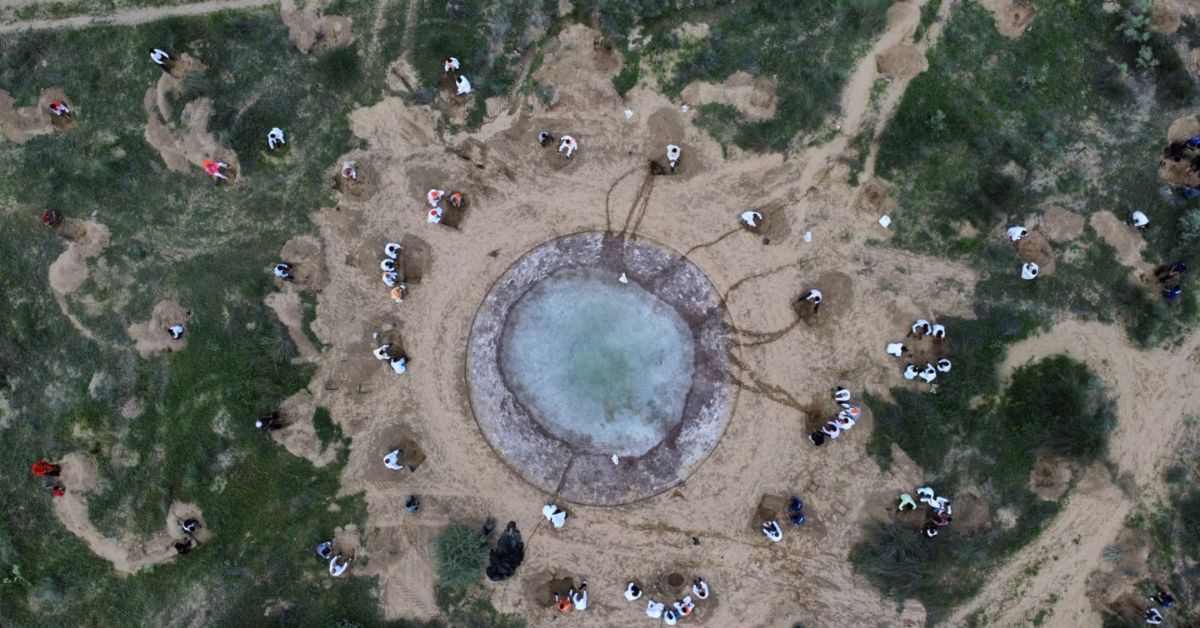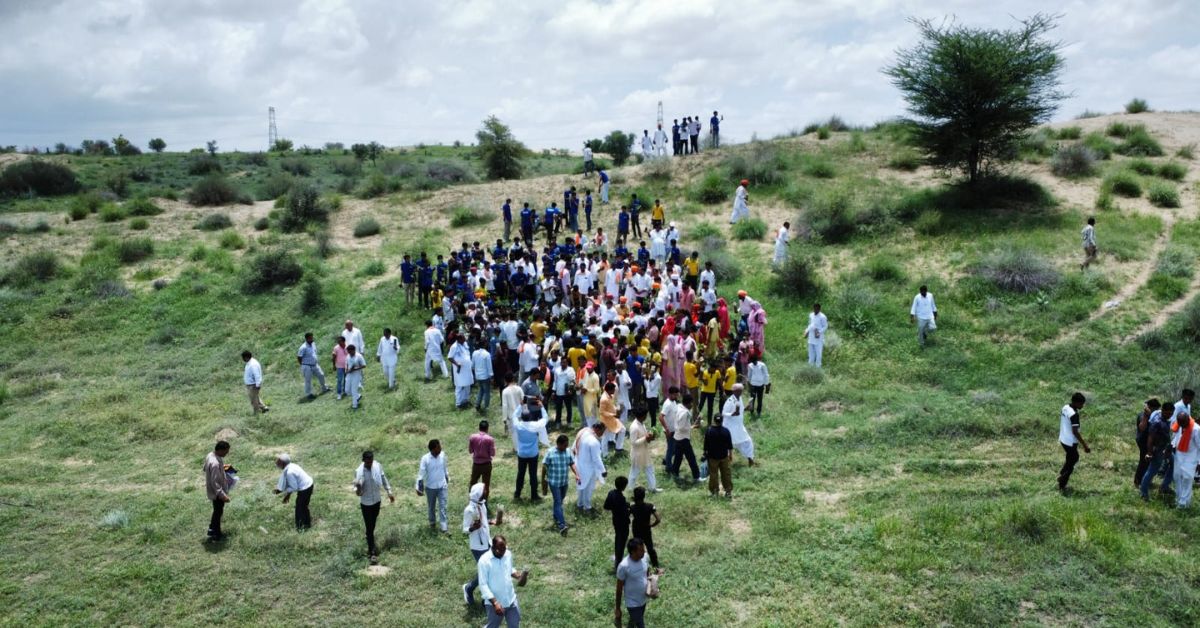The Dabla Talab reservoir, positioned close to the village of Uttamdesar within the Bikaner district of Rajasthan, suffered substantial devastation because of relentless gypsum mining for over 20 years.
The rampant extraction of gypsum, a typical mineral within the area, led to the disappearance of many animal species and native grass. Earlier than the arrival of the Indira Gandhi Canal, the reservoir was the first water supply for the villagers and wildlife.
Sadly, these operations left the world riddled with deep pits and towering hills of mining waste. This extreme environmental degradation not solely stripped the land of its assets but additionally instilled concern among the many locals, as girls had been notably hesitant to go via the abandoned locale.
In 2022, an initiative led by environmentalist and trainer Shyam Sunder Jyani sought to revive this 84-hectare space.
By partaking the native Jasnathi neighborhood and halting unlawful mining, the world was fenced, and native timber and grass was replanted, steadily reworking the as soon as barren land right into a flourishing grazing floor.

Whereas doing so, Jyani not solely spent his wage for the trigger but additionally survived threats. We sat down with the professor to find out how he led the transformative restoration mission with the assistance of 1000’s of villagers.
Making a motion for the land devoured by greed
All of it started when Jyani discovered himself strolling via the gates of a authorities school in Rajasthan’Bikaner as an affiliate professor in 2003. It was a prestigious place for a sociologist from a farmer’s household, however his scholarly ambitions took an sudden flip.
The neem timber on campus had been withering, dying underneath an unyielding solar and utter neglect. Regardless of being urged by his principal to pay attention solely on educational obligations, the sight of dying timber stirred one thing deep inside him.
“My colleagues sneered. They might whisper behind my again that I used to be extra a farmer than a professor. Such remarks would deeply have an effect on me, however my roots in agriculture turned my supply of resilience relatively than disgrace,” says Jyani.
Decided, he took it upon himself to nurse the timber again to life with the assistance of his college students. This sparked a ardour for environmental activism that may ignite transformative change.
Through the years, Jyani’s environmental pursuits expanded past the campus. With its harsh local weather, Bikaner’s panorama introduced vital challenges to any vegetation. But, in 2022, it wasn’t simply the arid land he confronted but additionally the scars of voracious gypsum mining.

Close to Uttamdesar village, the once-bountiful Dabla Talab reservoir had been ravaged, rendered barren by many years of unchecked extraction. The devastation known as for intervention, and Jyani rose to the problem.
With the blessing of the villagers, he set his sights on restoring the land and neighborhood spirit alike.
Collective motion by 2500 villagers
On World Surroundings Day in June 2022, Jyani set out on an 18-day tour masking 4,000 kilometres distance throughout 104 villages. By the tour, Jyani sought to succeed in the guts of every neighborhood, spreading the message of sustainability and the significance of restoring their degraded lands.
“We labored with our core group of about 2,500 devoted residents from these villages. Along with this, our familial forestry initiative garnered assist from roughly two lakh people, whereas round 5,000 native college students assisted in managing the general public nursery,” shares Jyani.
This huge enterprise was not nearly restoring land however a rallying cry to reinvigorate neighborhood spirit and instill a deep-seated sense of duty in direction of nature.
Jyani and his group engaged instantly with the native communities. By private interactions, conferences, and collective discussions, they made individuals conscious of the harmful affect of unregulated mining and the pressing want for community-driven environmental stewardship.

Jyani’s motion went past consciousness; it aimed to encourage a sustained dedication to alter. Folks weren’t solely made conscious however had been additionally given possession of the change, with many villagers becoming a member of the efforts to fence off areas, plant native timber, and create water sources for wildlife.
The restoration started with demarcating and fencing the 84-hectare space across the reservoir. In the meantime, Jyani emphasised the significance of familial forestry. “This encourages households to deal with timber as members of their households,” he says.
This act alone despatched a strong message of reclamation and dedication. A whole bunch of native timber, together with the enduring khejri, had been planted, establishing a vibrant ecosystem the place none remained.
Jyani’s method was holistic. Replenished utilizing solar energy, 12 small ponds, turned sustainable water sources for the returning wildlife. Animals lengthy absent from the panorama — jackals, nilgai, and even the elusive Asiatic wild cat — started to reclaim their habitat.

A key success of this journey was the flexibility to lift round ₹1 crore from the mixed contributions of villagers. “The empowerment technique centered on a easy but efficient methodology: encouraging villagers to donate Re 1 every day. The message was clear — small, constant contributions might result in monumental change,” says Jyani.
“Villagers had been additionally motivated to contribute extra throughout private occasions like weddings and festivals, framing environmental conservation as each a private and communal act of celebration and stewardship,” he provides.
‘Struggle towards those that would destroy lands’
The battle, nevertheless, was not with out fierce resistance. Because the land healed, unlawful mining pursuits felt threatened and sought to undermine Jyani’s efforts. “Threats adopted, urging me to stop meddling, they usually warned me of accidents which may hurt me. I used to be suggested to solely deal with being a trainer,” recollects Jyani.
But, concern was no match for the depth of Jyani’s dedication. “Our combat was towards greater than the land alone,” he insisted, “it was towards those that would destroy it.”
Hansraj Motsra, a resident of Uttamdesar village, recollects the horrifying scenario they confronted earlier. “Unlawful miners ceaselessly moved vehicles via the world, making it unsafe to enterprise out at evening. The miners had their individuals watch to forestall anybody from recording their unlawful actions. Girls had been notably petrified of going out after darkish. Typically, the miners had been drunk,” he says.
Hansraj had his personal personal faculty, and there have been occasions he needed to be out on the sphere. On one event, after a mum or dad invited his for dinner, his automotive was stopped. “The lads who stopped me had arms with them. I needed to name that mum or dad for assist. After inquiries, I used to be requested to go away,” he provides.

Jyani took up the problem to with the district administration, and collectively, the are was given safety. “As a resident, my involvement was essential throughout a number of interrogations and narration of occasions,” provides Hansraj.
This involvement price Hansraj big monetary losses. At one level, his privately owned faculty had 400 college students, however many dad and mom withdrew their kids as a result of unsafe situations.
“The miners had employed some villagers. So, once we broke out, these villagers opposed us, however we additionally obtained assist from the residents of close by villages. Now, the identical neighborhood understands the significance of restoring the world, and college students have returned to my faculty,” he smiles.
In the meantime, Jyani usually funneled his wage towards the trigger, residing on modest means. “We operate with the assistance of donors, however usually, I might spend a significant a part of my wage to maintain the efforts. The unseen prices of non-public time, absence from house, and monetary sacrifice had been heavy, however I really feel the rewards of profound change had been vital,” he provides.
After the land was reworked, Jyani noticed a legacy resilient sufficient to endure challenges, a neighborhood empowered to maintain itself.
The place gypsum mud as soon as choked the land, vibrant ecosystems thrived. Almost 84 hectares have been restored, changing into a sanctuary for wildlife like jackals, deer, and majestic peacocks. The land, as soon as scarred by deep mining pits, now dances with grasses and timber swaying within the breeze.
Edited by Vidya Gowri; All photos courtesy Shyam Sunder Jyani